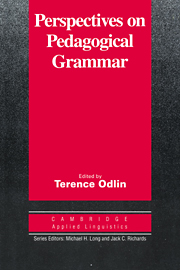Book contents
- Frontmatter
- Contents
- List of contributors
- Series editors' preface
- Preface
- Chapter 1 Introduction
- I WHAT SORT OF GRAMMAR?
- II GRAMMAR, LEXICON, AND DISCOURSE
- III PUTTING GRAMMAR TO WORK
- Chapter 9 The effect of systematic instruction on learning the English article system
- Chapter 10 Linguistic theory and pedagogic practice
- Chapter 11 The Introspective Hierarchy: A comparison of the intuitions of linguists, teachers, and learners
- Chapter 12 From printout to handout: Grammar and vocabulary teaching in the context of Data-driven Learning
- Chapter 13 Conclusion
- Glossary
- Index
Chapter 9 - The effect of systematic instruction on learning the English article system
Published online by Cambridge University Press: 05 October 2012
- Frontmatter
- Contents
- List of contributors
- Series editors' preface
- Preface
- Chapter 1 Introduction
- I WHAT SORT OF GRAMMAR?
- II GRAMMAR, LEXICON, AND DISCOURSE
- III PUTTING GRAMMAR TO WORK
- Chapter 9 The effect of systematic instruction on learning the English article system
- Chapter 10 Linguistic theory and pedagogic practice
- Chapter 11 The Introspective Hierarchy: A comparison of the intuitions of linguists, teachers, and learners
- Chapter 12 From printout to handout: Grammar and vocabulary teaching in the context of Data-driven Learning
- Chapter 13 Conclusion
- Glossary
- Index
Summary
The English article system consists of four items: a, an (a phonetic variant), the, and ∅ (the zero article). The simplicity of the words that make up the system masks the complexity of the rules for nativelike usage. For this reason, several researchers consider the article system to be unlearnable and therefore unteachable, that it can only be acquired through natural exposure to the language (e.g., Dulay, Burt, and Krashen 1982). For many language learners, especially those at the intermediate level and beyond, this is an unacceptable explanation. They usually have only a limited amount of time to spend in language courses, and they naturally expect to learn the language faster than they would by mere exposure. The present study describes a systematic program of instruction for teaching the article system to learners at this level and measures the effect of this program in a controlled quasi-experimental design.
In the early 1980s, communicative competence became the primary object of second language instruction, while grammatical instruction fell into disfavor because it was thought to influence the learner's monitor, or linguistic editor, but not to aid acquisition (Krashen 1981). The belief was that comprehensible (spoken) input provided by the instructor in a low-risk environment was sufficient for the learner to acquire grammatical competence. The pedagogical framework that embodies this belief is called the Natural Approach (Krashen and Terrell 1983) because it is meant to parallel first language acquisition. Even though Krashen's theories have since been challenged, many aspects of the Natural Approach are appropriate for the beginning levels of language instruction.
- Type
- Chapter
- Information
- Perspectives on Pedagogical Grammar , pp. 229 - 252Publisher: Cambridge University PressPrint publication year: 1994
- 21
- Cited by



